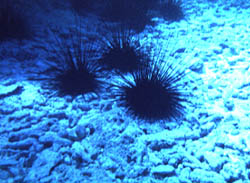Diadema antillarum is a major herbivore on Caribbean reefs. It feeds on fleshy algae, but also feeds on many species of sessile invertebrates, including juvenile corals. The urchin often spends time in crevices of patch reefs during the day, but forages at night on surrounding sea grass beds.
(www.wetwebmedia.com/urchins.htm; and life.bio.sunysb.edu/marinebio/coralreef.html)
 |
|
Photo
courtesy of SUNY Stony Brook
|
Figure 1 shows the average number of Diadema antillarum per square meter of sea floor in Jamaica from 1975 to 1995. There was a significant drop in the D. antillarum population in 1983. The population has not recovered since then.
- What do you think caused the initial drop in 1983?
- What is keeping the population from recovering?
- How do you think such a huge drop in sea urchin population affects the coral reef ecosystem?
|
 |
|
Figure 2. Percent of size distribution of Diadema antillarum in Jamaica in 1976 and 1993. |
Figure 2 compares average D. antillarum size via test diameter in 1976 and 1993. There has been a shift in average D. antillarum size from generally small animals in the 70s to considerably larger individuals in the 90s.
Comparing this information with the graph above, there appeared to be more abundant, small D. antillarum during the 1970s. Meanwhile, D. antillarum is less populous in the 1990s, but tend to be larger in size (and older).
Studies have shown that D. antillarum fertilization is density dependent. This means that successful fertilization of urchin eggs released into the water are dependent upon population density of adult urchins in the area.
- How can this shift in sea urchin size and number in Jamaican coral reefs impact the ecosystem and community structure?
Here are results from a study examining Diadema antillarum recovery, macroalgae cover, and coral abundance at five sites in Discovery Bay, Jamaica during January 2000. In this graph, researchers compared the number of D. antillarum per square meter in urchin or algal zones at each site.
Their results show that D. antillarum is noticeably more abundant in urchin zones.
- How does the higher density of D. antillarum in urchin zones affect the abundance of macroalgae and coral cover?
- Compare this result with coral and macroalgae abundance in these areas during the same study.
|
This web site was created by Lynn Tran at the North Carolina State University, Department of Mathematics, Science, and Technology Education on 7/12/03. Faculty advisor Dr. David Eggleston, NCSU, Department of Marine, Earth, & Atmospheric Sciences. Last updated December 29, 2003 .

